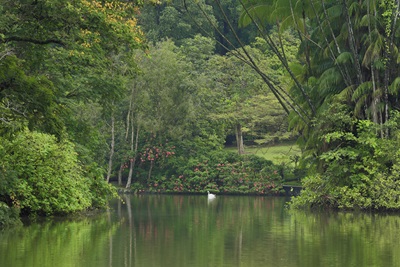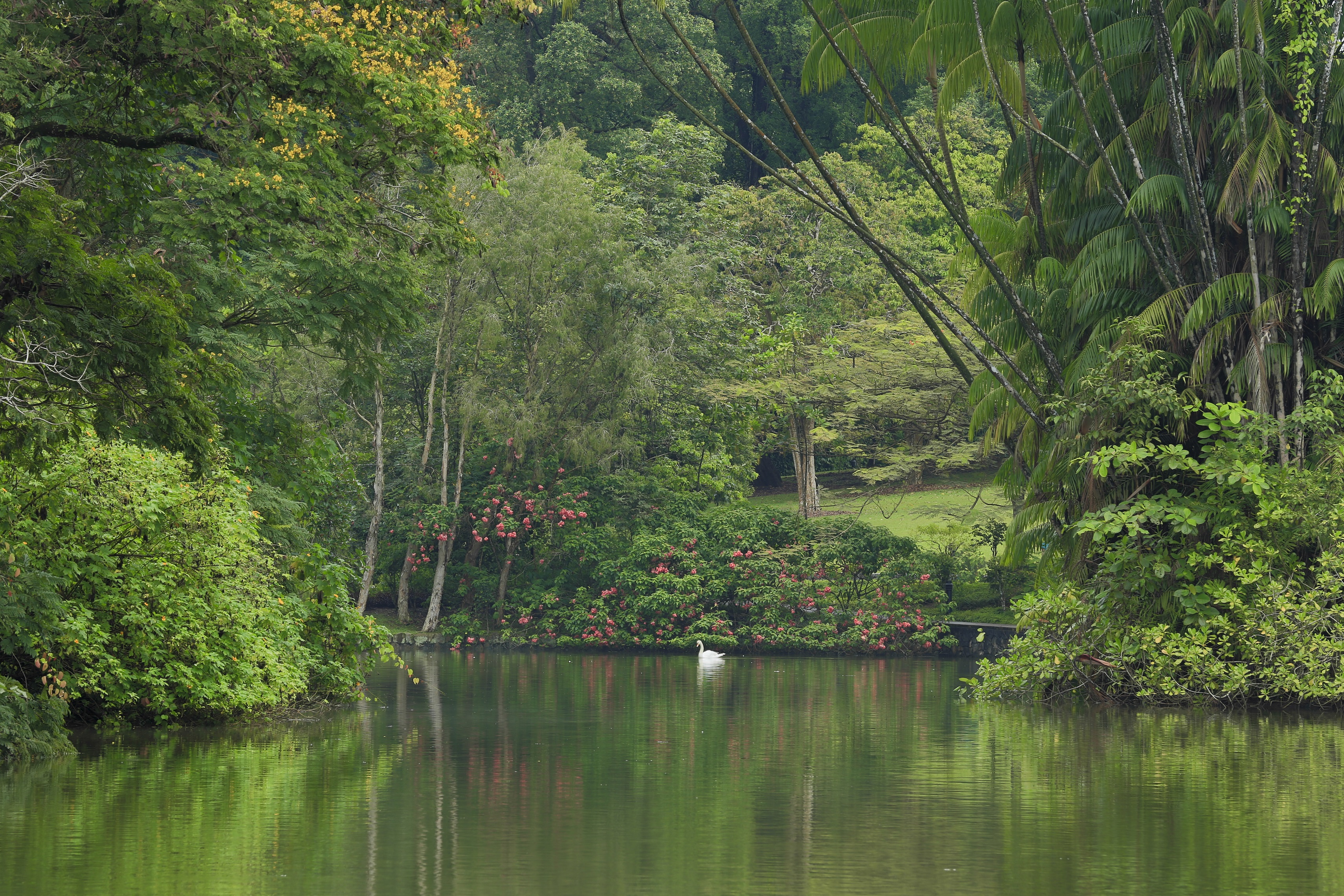Singapore Botanic Gardens’ Heritage Secrets

There’s more to the Singapore Botanic Gardens than meets the eye.
Steeped in rich heritage, here are some interesting historical facts about our first UNESCO Heritage Site that you may not know!
How the Gardens Came to Be
The colonial government granted 22 hectares of land in Tanglin to the Agri-Horticultural Society in 1859. This land was obtained from the merchant Hoo Ah Kay, who was a leading member of the Agri-Horticultural Society. This agreement provided the location for the Singapore Botanic Gardens.

Holttum Hall, the structure that houses the Singapore Botanic Gardens Heritage Museum, has architectural heritage value as well.
The Gardens was originally created as a pleasure garden for the members of the Agri-Horticultural Society and was laid out in the style of the English Landscape Movement which focused on natural features and free-flowing landscapes. During the late 19th and early 20th centuries the Gardens focused on trialling plants of economic value as well as ornamental plant cultivation. Many buildings in the Gardens have heritage value as well. If you visit the Seed Bank, Ethnobotany Centre or the Heritage Museum, be sure to pause and admire the historical architecture of these buildings.
Why ‘Botanic’ and Not ‘Botanical’?

Look for the Meranti Melanti (Shorea macroptera) Heritage Tree found in the Gardens. Photo credit: Benjamin Aw
Have you ever wondered why it isn’t named the ‘Singapore Botanical Gardens’? For the adjective meaning of or relating to botany or the cultivation of plants, ‘botanic’ and ‘botanical’ are both acceptable, and there is no difference between them.
‘Botanic’ is the older form of the adjective, while ‘botanical’ is more commonly used today. Although its use may have gradually faded over time, it has been kept in the names of many botanical institutions founded over a century ago, as is reflected in the name of our own garden!
Crocodile in the Lake

The tranquil Swan Lake is named after a pair of Mute Swans that made it their home in the late 19th century.
Swan Lake, constructed in 1866 shortly after the Gardens was established, is considered to be the oldest ornamental water feature in Singapore. Originally called First Lake or Main Lake, it was renamed after a pair of Mute Swans from the Netherlands that made the lake their home.
The lake is slightly less than 1.5 hectares, approximately 4 metres in depth, and provides habitat for numerous species of aquatic plants and fishes. But did you know that it played host to an escaped crocodile in the late 1800s? The lake was drained to catch the reptile, so when you visit the Gardens today, you do not have to worry about having a surprising encounter!
Living History

Stepping into the Singapore Botanic Gardens’ Rain Forest, part of the original site of the Botanic Gardens in 1859, is like a walk back in time. Photo credit: Benjamin Aw
Did you know that the Singapore Botanic Gardens’ Rain Forest is one of the only remnants of primary rainforest left in Singapore? Located in the heart of the city and only a hop away from Singapore's busiest shopping precinct, Orchard Road, the 6.2-hectare rainforest is home to more than 300 species of flora.
It is a national treasure not only for its rich biodiversity, but also because it is part of the original site of the Botanic Gardens founded in 1859. Given that more than 80% of the plant species found in the Rain Forest are rare or endangered in Singapore, it plays an important role in ensuring the conservation of these species.
Oldest Reference Library in Southeast Asia

Leaf through the many resource materials in the library at Botany Centre, one of the oldest reference libraries in Southeast Asia.
The Singapore Botanic Gardens is more than a garden, it also houses one of the oldest reference libraries in Southeast Asia. It was established in 1875 and is almost as old as the Gardens itself!
Located in the Botany Centre, it contains more than 30,000 books, periodicals, historical maps and botanical artwork. Although access to many of these historical materials is restricted for their protection, the Public Reference Library showcases herbarium specimens of plants common in Singapore, and offers a range of books and other horticultural and botanical resources for visitors to peruse. From early November 2020, the Public Library Section will be open from 9 am to 5 pm, Monday to Friday. It is closed on the weekends and on Public Holidays.
Visit the Singapore Botanic Gardens and enjoy an intrinsic part of Singapore’s history. For more information: https://www.nparks.gov.sg/sbg.
Celebrating Heritage
The annual Singapore Botanic Gardens Heritage Festival is back and there are many activities to enjoy online and onsite!
To celebrate and learn more about the rich heritage of the Gardens, join virtual tours of the Heritage Museum, Seed Bank and Herbarium, which will be available on NParksSG YouTube channel.
Go on a Singapore Botanic Gardens Heritage Trail, one of our NParks virtual tours, to explore the Gardens’ heritage secrets.
And be sure to join in the special online NAC-ExxonMobil Concert in the Gardens Series - the Singapore Botanic Gardens Heritage Festival edition on 31 October! The Singapore Botanic Gardens Heritage Festival is on to 1 November 2020.
Enjoy a piece of our rich heritage in your home or office! Pick up the 2021 Singapore Botanic Gardens Calendar. The botanical watercolours featured in this calendar are from the Gardens’ collections of botanical art. They feature paintings of orchids to commemorate the 25th anniversary of the National Orchid Garden. The orchids are species found in the wild in Singapore and the surrounding region, or are hybrids created in Singapore.
The calendar is available in any Gardens Shop and from our online shop at www.botanicgardensshop.sg. Check out this month’s contest to win yourself the calendar!
Learning More
If you are heading to our green spaces, do the right thing and be socially responsible. Maintain a safe distance from other park goers and keep to not more than five persons in a group. Always wear a mask except when you are engaged in strenuous exercise or when consuming food, drink or medication.
Do check out the visitorship levels of our parks using our safe distancing portal before you head down and avoid the ones with high visitorship.
Visit NParksSG, our YouTube Channel that serves as a one-stop repository for close to 300 video resources. The videos range from DIY gardening and related crafts to virtual tours of our green spaces and livestream events.
For more information about the flora and fauna found in Singapore, please visit NParks Flora and Fauna Web.
If you like what you read, follow us on Facebook, Instagram and Telegram to get the latest updates.
Text by Bryan Wu
About the writer
Bryan Wu is a third year Journalism student from Nanyang Technological University’s Wee Kim Wee School of Communications and Information. As part of his school’s professional internship programme he chose to intern at NParks’ Communications and Community Engagement department. In this time, he has created posts for NParks’ social media platforms, assisted with NParks video productions and written articles for My Green Space.
Please email wong_yeang_cherng@nparks.gov.sg for more information on our internship programme.





Have views or comments on this article? Let us know via this form. If you would like to give us feedback on any other areas relating to our parks and gardens, please submit via https://www.nparks.gov.sg/feedback